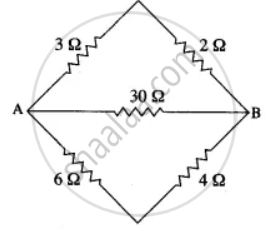Advertisements
Advertisements
प्रश्न
A p.d. of 6 V is applied to two resistors of 3 Ω and 6 Ω connected in parallel. Calculate:
(a) the combined resistance
(b) the current flowing in the main circuit
(c) the current flowing in the 3 Ω resistor.
उत्तर
(a) The resistors of 3 Ω and 6 Ω are connected in parallel. Therefore, their net resistance can be calculated as:
1/R = 1/R1 + 1/R2
Here, R1 = 3 Î
R2 = 6 Î
So:
1/R = (1/3) + (1/6)
1/R = (2 + 1)/6
1/R = 3/6
R = 2 Ω
(b) The current flowing through the main circuit,
I = V/R
I = 6/2 A
I = 3 A
(c) The current flowing in the 3 Ω resistor,
I = V/R
I = 6/3 = 2 A
APPEARS IN
संबंधित प्रश्न
1 A = _________ mA
- 102
- 103
- 10-3
- 10-6
If 20 C of charge pass a point in a circuit in 1 s, what current is flowing?
Calculate the equivalent resistance between A and B in the adjacent diagram.

Define the following:
Super conductors.
An electric bulb is marked 100 W, 250 V. How much current will the bulb draw if connected to a 250 V supply?
Which of the following represents voltage?
